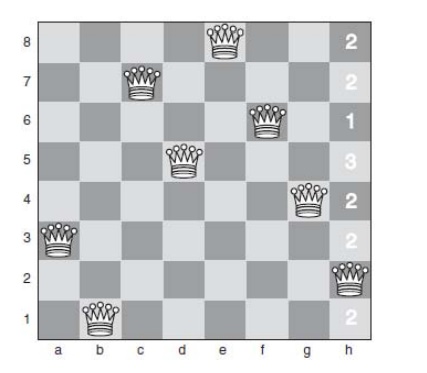Chapter: Artificial Intelligence
Heuristic Repair
Heuristic Repair
Heuristics can be used to improve performance of solutions to
constraint satisfaction problems.
One way to do this is to use a heuristic repair method, which
involves generating a possible solution (randomly, or using a heuristic to
generate a position that is close to a solution) and then making changes that
reduce the distance of the state from the goal.
In the case of the eight-queens problem, this could be done
using the minconflicts heuristic.
To move from one state to another state that is likely to be
closer to a solution using the min-conflicts heuristic, select one queen that
conflicts with another queen (in other words, it is on the same row, column, or
diagonal as another queen).
Now move that queen to a square where it conflicts with as few
queens as possible. Continue with another queen. To see how this method would
work, consider the starting position shown in Fig 6.3.

This starting position has been generated by placing the queens
such that there are no conflicts on rows or columns. The only conflict here is
that the queen in column 3 (on c7) is on a diagonal with the queen in column h
(on h2).
To move toward a solution, we choose to move the queen that is
on column h.
We will only ever apply a move that keeps a queen on the same
column because we already know that we need to have one queen on each column.
Each square in column h has been marked with a number to show
how many other queens that square conflicts with. Our first move will be to
move the queen on column h up to row 6, where it will conflict only with one
queen. Then we arrive at the position shown in below Fig
Because we have created a new conflict with the queen on row 6
(on f6), our next move must be to move this queen. In fact, we can move it to a
square where it has zero conflicts. This means the problem has been solved, and
there are no remaining conflicts.
This method can be used not only to solve the eight-queens
problem but also has been successfully applied to the n-queens problem for
extremely large values of n. It has been shown that, using this method, the
1,000,000 queens problem can be solved in an average of around 50 steps.
Solving the 1,000,000-queens problem using traditional search
techniques would be impossible because it would involve searching a tree with a
branching factor of 1012.

Local Search and Metaheuristics
Local
search methods work by starting from some initial configuration (usually
random) and making small changes to the configuration until a state is reached
from which no better state can be achieved.
Hill
climbing is a good example of a local search technique.
Local
search techniques, used in this way, suffer from the same problems as hill
climbing and, in particular, are prone to finding local maxima that are not the
best solution possible.
The
methods used by local search techniques are known as metaheuristics.
Examples
of metaheuristics include simulated annealing, tabu search, genetic algorithms,
ant colony optimization, and neural networks.
This kind
of search method is also known as local optimization because it is attempting
to optimize a set of values but will often find local maxima rather than a
global maximum.
A local
search technique applied to the problem of allocating teachers to classrooms
would start from a random position and make small changes until a configuration
was reached where no inappropriate allocations were made.
Exchanging Heuristics
The
simplest form of local search is to use an exchanging heuristic.
An
exchanging heuristic moves from one state to another by exchanging one or more
variables by giving them different values. We saw this in solving the
eight-queens problem as heuristic repair.
A
k-exchange is considered to be a method where k variables have their values
changed at each step.
The
heuristic repair method we applied to the eight-queens problem was 2-exchange.
A
k-exchange can be used to solve the traveling salesman problem. A tour (a route
through the cities that visits each city once, and returns to the start) is
generated at random. Then, if we use 2-exchange, we remove two edges from the
tour and substitute them for two other edges. If this pro duces a valid tour
that is shorter than the previous one, we move on from here. Otherwise, we go
back to the previous tour and try a different set of substitutions.
In fact,
using k = 2 does not work well for the traveling salesman problem, whereas
using k = 3 produces good results.
Using
larger numbers of k will give better and better results but will also require
more and more iterations.
Using k =
3 gives reasonable results and can be implemented efficiently. It does, of
course, risk finding local maxima, as is often the case with local search
methods.
Iterated Local Search
Iterated
local search techniques attempt to overcome the problem of local maxima by
running the optimization procedure repeatedly, from different initial states.
If used
with sufficient iterations, this kind of method will almost always find a
global maximum.
The aim,
of course, in running methods like this is to provide a very good solution
without needing to exhaustively search the entire problem space.
In
problems such as the traveling salesman problem, where the search space grows
extremely quickly as the number of cities increases, results can be generated
that are good enough (i.e., a local maximum) without using many iterations,
where a perfect solution would be impossible to find (or at least it would be
impossible to guarantee a perfect solution even one iteration of local search
may happen upon the global maximum).
Related Topics